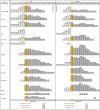Clinical manifestations and case management of Ebola haemorrhagic fever caused by a newly identified virus strain, Bundibugyo, Uganda, 2007-2008
- PMID: 23285243
- PMCID: PMC3532309
- DOI: 10.1371/journal.pone.0052986
Clinical manifestations and case management of Ebola haemorrhagic fever caused by a newly identified virus strain, Bundibugyo, Uganda, 2007-2008
Abstract
A confirmed Ebola haemorrhagic fever (EHF) outbreak in Bundibugyo, Uganda, November 2007-February 2008, was caused by a putative new species (Bundibugyo ebolavirus). It included 93 putative cases, 56 laboratory-confirmed cases, and 37 deaths (CFR = 25%). Study objectives are to describe clinical manifestations and case management for 26 hospitalised laboratory-confirmed EHF patients. Clinical findings are congruous with previously reported EHF infections. The most frequently experienced symptoms were non-bloody diarrhoea (81%), severe headache (81%), and asthenia (77%). Seven patients reported or were observed with haemorrhagic symptoms, six of whom died. Ebola care remains difficult due to the resource-poor setting of outbreaks and the infection-control procedures required. However, quality data collection is essential to evaluate case definitions and therapeutic interventions, and needs improvement in future epidemics. Organizations usually involved in EHF case management have a particular responsibility in this respect.
Conflict of interest statement
Figures




References
-
- Feldmann H, Geisbert T, Jahrling P, Klenk H, Netesov S, et al... (2004) Filoviridae In: C.MFauquet MAM, JManiloff, UDesselberger, L.ABall, editor. Virus Taxonomy, VIIIth Report of the ICTV. London: Elsevier/Academic Press. pp. 645–653.
-
- Kuhn J (2008) Filoviruses: a compendium of 40 years of epidemiological, clinical, and laboratory studies. Wien: Springer. - PubMed
-
- WHO, CDC (1998) Infection Control for Viral Haemorrhagic Fevers in the African Health Care Setting. Available: http://www.who.int/csr/resources/publications/ebola/WHO_EMC_ESR_98_2_EN/en/. Accessed 13 November 2012. Geneva: WHO.
-
- Formenty P, Libama F, Epelboin A, Allarangar Y, Leroy E, et al. (2003) [Outbreak of Ebola hemorrhagic fever in the Republic of the Congo, 2003: a new strategy?]. Med Trop (Mars) 63: 291–295. - PubMed
-
- Leroy EM, Rouquet P, Formenty P, Souquiere S, Kilbourne A, et al. (2004) Multiple Ebola virus transmission events and rapid decline of central African wildlife. Science 303: 387–390. - PubMed
Publication types
MeSH terms
Grants and funding
LinkOut - more resources
Full Text Sources
Medical

